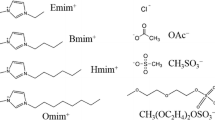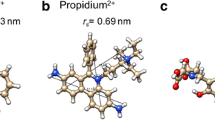ABSTRACT
Purpose
To investigate the permeation of two ionisable drug molecules, warfarin and verapamil, across artificial membranes. For the first time since the introduction of the parallel artificial membrane permeation assay (PAMPA) in 1998, in situ permeation-time profiles of drug molecules are studied.
Methods
The method employs a rotating-diffusion cell where the donor and acceptor compartments are separated by a lipid-impregnated artificial membrane. The permeation of the solute is investigated under well-defined hydrodynamic conditions with control over the unstirred water layer. The flux of the permeating molecule is analysed in situ using UV spectrophotometry.
Results
In situ permeation-time profiles are obtained under hydrodynamic control and used to determine permeability coefficients. An advanced analytical transport model is derived to account for the membrane retention, two-way flux and pH gradient between the two compartments. Moreover, a numerical permeation model was developed to rationalise the time-dependent permeation profiles. The membrane permeability, intrinsic permeability and unstirred water permeability coefficients of two drug molecules are obtained from two independent methods, hydrodynamic extrapolation and pH profiling, and the results are compared.
Conclusions
Both warfarin and verapamil exhibit high permeability values, which is consistent with the high fraction absorbed in human. Our results demonstrate that a considerable lag-time, varying with the solute lipophilicity and stirring rate, exists in membrane permeation and leads to incorrect compound ranking if it is not treated properly. Comparison of the permeability data as a function of pH and stirring rate suggests that some transport of the ionized molecules occurs, most likely via ion-pairing.








Similar content being viewed by others
Abbreviations
- A :
-
membrane area
- α :
-
hydrodynamic exponent
- BM-PAMPA:
-
bio-mimetic PAMPA
- c(t):
-
time-dependent solute concentration
- Caco-2:
-
colorectal adenocarcinoma cell epithelial line
- CHES:
-
2-(Cyclohexylamino)ethanesulfonic acid
- D aq :
-
aqueous diffusion coefficient
- D m :
-
membrane diffusion coefficient
- DOPC:
-
dioleoyl phosphatidylcholine
- DOPC-PAMPA:
-
dioleoyl phosphatidylcholine PAMPA
- DS-PAMPA:
-
double-sink PAMPA
- f n :
-
neutral fraction of the solute
- h :
-
membrane thickness
- HDM-PAMPA:
-
hexadecane PAMPA
- IAM:
-
immobilised artificial membrane
- J(t):
-
time-dependent solute flux
- K d :
-
distribution coefficient
- K OCT :
-
octanol/water distribution coefficient
- MDCK:
-
Madin-Darby canine kidney epithelial cell line
- P :
-
(not specified) permeability coefficient
- P 0 :
-
intrinsic permeability coefficient
- PAMPA:
-
parallel artificial membrane permeation assay
- P e :
-
effective (measured) permeability coefficient
- P m :
-
membrane permeability coeffcient
- PTFE:
-
polytetrafluoroethylene
- P u :
-
unstirred water layer permeability coefficient
- PVDF:
-
polyvinylidene fluoride
- R :
-
fractional membrane retention
- t :
-
time
- UWL:
-
unstirred water layer
- V :
-
volume
- δ UWL :
-
unstirred water layer thickness
- ν :
-
kinematic viscosity
- τ LAG :
-
lag-time
REFERENCES
Fade V. Link between drug absorption solubility and permeability measurements in Caco-2 cells. J Pharm Sci. 1998;87:1604–7.
Artursson P, Karlsson J. Correlation between oral drug absorption in humans and apparent drug permeability coefficients in human intestinal epithelial (CACO-2) cells. Biochem Biophys Res Commun. 1991;17:880–5.
Irvine JD, Takahashi L, Lockhart K, Cheong J, Tolan JW, Selick HE et al. MDCK (Madin-Darby canine kidney) cells: a tool for membrane permeability screening. J Pharm Sci. 1999;88:28–33.
Galinis-Luciani D, Nguyen L, Yazdanian M. Is PAMPA a useful tool for discovery? J Pharm Sci. 2007;96:2886–92.
Avdeef A, Bendels S, Di L, Faller B, Kansy M, Sugano K et al. PAMPA - Critical factors for better predictions of absorption. J Pharm Sci. 2007;96:2893–909.
Avdeef A. The rise of PAMPA. Expert Opin Drug Metab Toxicol. 2005;1:325–42.
Mälkia A, Murtomäki L, Urtti A, Kontturi K. Drug permeation in biomembranes: In vitro and in silico prediction and influence of physicochemical properties. Eur J Pharm Sci. 2004;23:13–47.
Avdeef A. Absorption and Drug Development: Solubility, Permeability, and Charge State, Wiley-Interscience, 2003.
Avdeef A. High-throughput measurement of permeability profiles, Drug Bioavailability, Wiley-VCH Weinheim, 2003.
Kansy M, Senner F, Gubernator K. Physicochemical high throughput screening: parallel artificial membrane permeation assay in the description of passive absorption processes. J Med Chem. 1998;41:1007–10.
Kansy M, Fischer H, Kratzat K, Senner F, Wagner B, and Parilla I. High-Throughput Artificial Membrane Permeability Studies in Early Lead Discovery and Development, Pharmacokinetic Optimization in Drug Research. Helvetic Chim Acta. 2001.
Avdeef A, Strafford M, Block E, Balogh MP, Chambliss W, Khan I. Drug absorption in vitro model: Filter-immobilized artificial membranes: 2. Studies of the permeability properties of lactones in Piper methysticum Forst. Eur J Pharm Sci. 2001;14:271–80.
Bermejo M, Avdeef A, Ruiz A, Nalda R, Ruell JA, Tsinman O et al. PAMPA - a drug absorption in vitro model 7. Comparing rat in situ, Caco-2, and PAMPA permeability of fluoroquinolones. Eur J Pharm Sci. 2004;21:429–41.
Avdeef A, Nielsen PE, Tsinman O. PAMPA - A drug absorption in vitro model: 11. Matching the in vivo unstirred water layer thickness by individual-well stirring in microtitre plates. Eur J Pharm Sci. 2004;22:365–74.
Sugano K, Hamada H, Machida M, Ushio H, Saitoh K, Terada K. Optimized conditions of bio-mimetic artificial membrane permeation assay. Int J Pharm. 2001;228:181–8.
Sugano K, Nabuchi Y, Machida M, Aso Y. Prediction of human intestinal permeability using artificial membrane permeability. Int J Pharm. 2003;257:245–51.
Sugano K, Takata N, Machida M, Saitoh K, Terada K. Prediction of passive intestinal absorption using bio-mimetic artificial membrane permeation assay and the paracellular pathway model. Int J Pharm. 2002;241:241–51.
Wohnsland F, Faller B. High-throughput permeability pH profile and high-throughput alkane/water log P with artificial membranes. J Med Chem. 2001;44:923–30.
Faller B, Grimm HP, Loeuillet-Ritzler F, Arnold S, Briand X. High-throughput lipophilicity measurement with immobilized artificial membranes. J Med Chem. 2005;48:2571–6.
Chen X, Murawski A, Patel K, Crespi CL, Balimane PV. A novel design of artificial membrane for improving the PAMPA model. Pharm Res. 2008;25:1511–20.
Flaten GE, Skar M, Luthman K, Brandl M. Drug permeability across a phospholipid vesicle based barrier: 3. Characterization of drug-membrane interactions and the effect of agitation on the barrier integrity and on the permeability. Eur J Pharm Sci. 2007;30:324–32.
Flaten GE, Dhanikula AB, Luthman K, Brandl M. Drug permeability across a phospholipid vesicle based barrier: a novel approach for studying passive diffusion. Eur J Pharm Sci. 2006;27:80–90.
Flaten GE, Bunjes H, Luthman K, Brandl M. Drug permeability across a phospholipid vesicle-based barrier. 2. Characterization of barrier structure, storage stability and stability towards pH changes. Eur J Pharm Sci. 2006;28:336–43.
Di L, Kerns EH, Fan K, McConnell OJ, Carter GT. High throughput artificial membrane permeability assay for blood-brain barrier. Eur J Med Chem. 2003;38:223–32.
Przybylo M, Olzynska A, Han S, Ozyhar A, Langner M. A fluorescence method for determining transport of charged compounds across lipid bilayer. Biophys Chem. 2007;129:120–5.
Gjelstad A, Rasmussen KE, Pedersen-Bjergaard S. Electrokinetic migration across artificial liquid membranes. Tuning the membrane chemistry to different types of drug substances. J Chrom. 2006;1124:29–34.
Balon K, Riebesehl BU, Müller BW. Drug liposome partitioning as a tool for the prediction of human passive intestinal absorption. Pharm Res. 1999;16:882–8.
Seo PR, Teksin ZS, Kao JPY, Polli JE. Lipid composition effect on permeability across PAMPA. Eur J Pharm Sci. 2006;29:259–68.
Avdeef A, Artursson P, Neuhoff S, Lazorova L, Gråsjö J, Tavelin S. Caco-2 permeability of weakly basic drugs predicted with the Double-Sink PAMPA pKa flux method. Eur J Pharm Sci. 2005;24:333–49.
Adson A, Burton PS, Raub TJ, Barsuhn CL, Audus KL, Ho NFH. Passive diffusion of weak organic electrolytes across Caco-2 cell monolayers: Uncoupling the contributions of hydrodynamic, transcellular, and paracellular barriers. J Pharm Sci. 1995;84:1197–204.
Karlsson J, Artursson P. A method for the determination of cellular permeability coefficients and aqueous boundary layer thickness in monolayers of intestinal epithelial (Caco-2) cells grown in permeable filter chambers. Int J Pharm. 1991;71:55–64.
Lennernäs H. Human intestinal permeability. J Pharm Sci. 1998;87:403–10.
Molloy BJ, Tam KY, Wood JM, Dryfe RAW. A hydrodynamic approach to the measurement of the permeability of small molecules across artificial membranes. Analyst. 2008;133:655–9.
Mayer PT, Anderson BD. Transport across 1, 9-decadiene precisely mimics the chemical selectivity of the barrier domain in egg lecithin bilayers. J Pharm Sci. 2002;91:640–6.
Levich VG. Physicochemical hydrodynamics. London: Englewood Cliffs; 1962.
Albery WJ, Burke JF, Leffler EB, Hadgraft J. Interfacial transfer studied with a rotating diffusion cell. J Chem Soc Faraday Trans I. 1976;72:1618–26.
Guyand RH, Honda DH. Solute transport resistance at the octanol - water interface. Int J Pharm. 1984;19:129–37.
Leahy DE, Wait AR. Solute transport resistance at water-oil interfaces. J Pharm Sci. 1986;75:1157–61.
Amidon GE, Higuchi WI, Ho NFH. Theoretical and experimental studies of transport of micelle-solubilized solutes. J Pharm Sci. 1982;71:77–84.
Shore PA, Brodie BB, Hogben CAM. The gastric secretion of drugs - a pH partition hypothesis. J Pharmacol Exp Ther. 1957;119:361–9.
Atkins P, de Paula J. Physical chemistry for the life sciences. Oxford University Press, 2006.
Charcosset C, Bernengo JC. Comparison of microporous membrane morphologies using confocal scanning laser microscopy. J Membr Sci. 2000;168:53–62.
Sarveiya V, Templeton JF, Benson HAE. Ion-pairs of ibuprofen: Increased membrane diffusion. J Pharm Pharmacol. 2004;56:717–24.
Takacs-Novak K, Szasz G. Ion-pair partition of quaternary ammonium drugs: the influence of counter ions of different lipophilicity, size, and flexibility. Pharm Res. 1999;16:1633–8.
Neubert R. Ion pair transport across membranes. Pharm Res. 1989;6:743–7.
Dollery CT. Therapeutic drugs. Churchill Livingstone, 1999.
Obach RS, Lombardo F, Waters NJ. Trend analysis of a database of intravenous pharmacokinetic parameters in human for 670 drug compounds. Drug Metab Dispos. 2008;36:1385–405.
ACKNOWLEDGEMENTS
We thank our industrial collaborator, AstraZeneca, and EPSRC for funding and Dr. J. Matthew Wood (AstraZeneca, Alderley Park) for consultation and training in the industrial PAMPA method.
Author information
Authors and Affiliations
Corresponding authors
Electronic Supplementary Materials
Below is the link to the electronic supplementary material.
Appendix
(DOC 1812 kb)
Rights and permissions
About this article
Cite this article
Velický, M., Bradley, D.F., Tam, K.Y. et al. In Situ Artificial Membrane Permeation Assay under Hydrodynamic Control: Permeability-pH Profiles of Warfarin and Verapamil. Pharm Res 27, 1644–1658 (2010). https://doi.org/10.1007/s11095-010-0150-6
Received:
Accepted:
Published:
Issue Date:
DOI: https://doi.org/10.1007/s11095-010-0150-6




